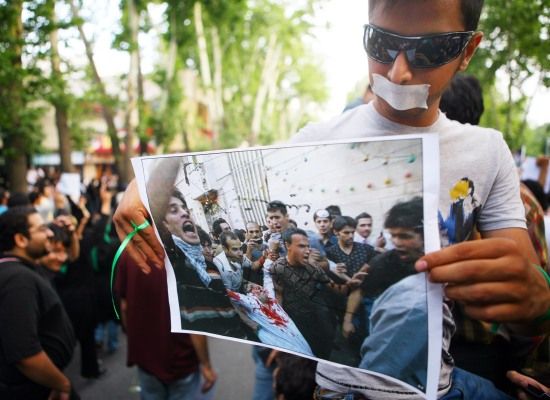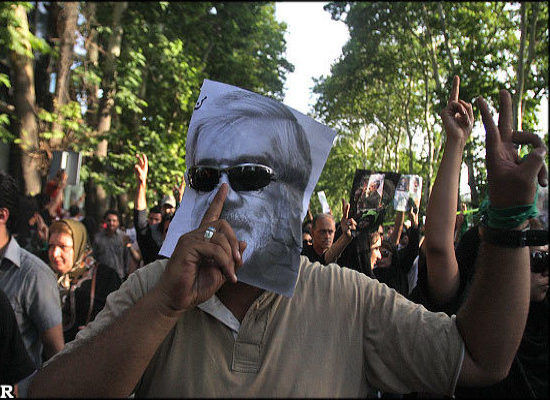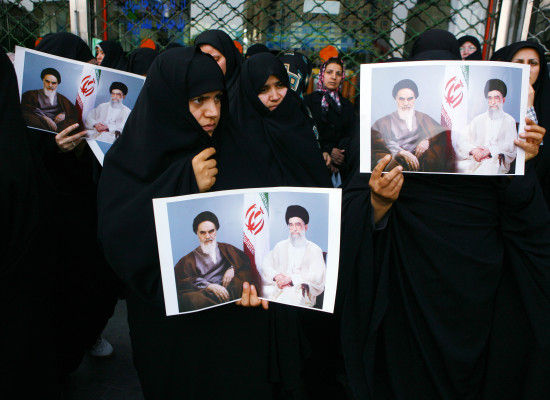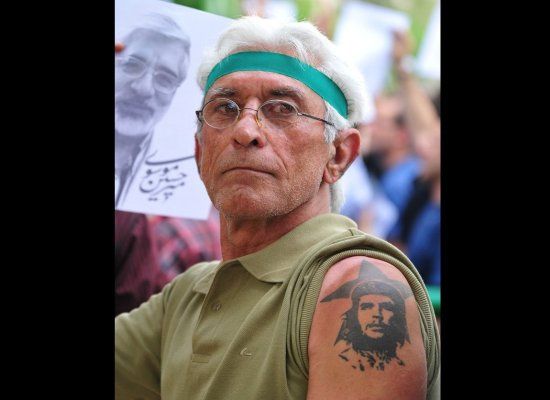Commentators on photography frequently claim that the image is a counterfeit of reality. Beware the image, we’re told, as it is not the real thing. But it you look at what people do with images, you can see far more than people being mislead. What I find particularly notable is how ordinary people are enlisting images as foot soldiers in public demonstrations. Instead of displacing reality, images are being used to increase the scale and impact of democratic advocacy.
You could see it as Chinese parents held photographs of children killed when their schools collapsed during an earthquake, and you can see it now as Iranians protest their government’s attempt to fix the presidential election.

Here a protester is not only marching in the street but displaying a photo of another protester who was shot by a government thug in an earlier demonstration. For an example using an earlier photo of state violence, look at the bottom of this post, and see others in photograph 9 at The Big Picture. That’s only part of the repertoire, however.

I doubt anyone thinks this guy actually is Mir Moussavi, so the protectors of reality can stand down for a moment. He is doing something much more significant than imitation, anyway: by making the photograph a mask for this political theater, he puts the political leader’s face on the body politic that is the multitude of people in the street. The leader, who actually is living on the edge of house arrest, is given the force of the people, whose identification with his cause and their right to a fair election is given specific statement.
There may be more going on as well. This carnivalesque mashup may also be a response to the State’s attempt to mobilize the same means of persuasion on behalf of their theocratic regime, as they do here:

These women are holding photos in a demonstration on behalf of Mahmoud Ahmadinejad. The stock portrait of Leaders with the Flag and corresponding production values are in sharp contrast to the dynamic documentary witness in the first image above. If you want to communicate Order and Stability instead of change, however, this state-sponsored image will do.
It’s tempting to leave it at that: a contest between competing images that reflects the two sides of the polarized confrontation in the street. The disenfranchised people, their candidate, and a dynamic visual culture on one side, and traditionalist social orders, clerical leaders, and propaganda on the other. But I want to tip the scales further on behalf of democratic public art, which, after all, should be too brash and ungainly to be easily categorized. For that and other reasons as well, you really ought to get a look at this:

The photographs are from the slide show at the Huffington Post. Photographs 1-3 are Getty images; I don’t have an ID on 4.
[…] ” by Sir Ken Robinson is a book on passion, creativity, and, most importantly, education Showing Political Action: Images in the Iranian Protests – nocaptionneeded.com 06/17/2009 Commentators on photography frequently claim that the image is a […]
I think it is important to note that the man with the Moussavi mask is also literally standing behind Aga Moussavi’s protection. Photos of his supporters regularly show them in masks to hide their identity in fear of future retaliation from the government.
[…] See more here: Showing Political Action: Images in the Iranian Protests […]
The trope of photos inside the frames of our published news images, emanating from hands or rising up above heads, breathes as another limb, a new body part to anatomize in a cue for us, the viewers, to imbibe our visual bombardments as border-less. As a daily newsprint reader, I often fixate on what hinges at the bottom of the frame, does not get refreshed or replaced, but sticks on the cheap paper. Before the caption attempts context is usually the name of the photographer. Depending on the agency and rights and economy of those exchanges all of which I am not an expert on.
The photos inside photos reality we live in, is to me in a sort of synchronized swimming with the camera phones in street protesters’ pockets. So this week I started taking note, in the New York Times coverage of the election protests in Iran, how anonymous images, to protect identity and to nod that professional photography is largely a business of just being there or not being there (by way of privilege or by way of censorship) to gain front page access.
But an image in the paper without a photographer’s name then takes the name of the company that prints it and to me that doesn’t seem right. An image within an image similarly has no attribution, dissolves from the routine of contextualizing, but at least is owned by the physical movements of whoever places it inside the photo. It is in the realm of choreography; owned by the people or place it comes from. I call for a sort of obsessive tracking of who took what. In a way this would never happen; thus the need for the fantasy and imagination of interpretation, constantly of our visual bombardments. However impossible, I don’t want big businesses names (i.e. Youtube) underneath a Neda Agha-Soltan’s video still. What are other options besides the brokers of our media?
[…] I’ve found interesting as discussions on the images themselves. The first comes from the No Caption Needed blog which discusses the differing uses made of photographs by pro-Ahmadinejad supporters […]
I like your phrase “images as foot soldiers in public demonstrations.”
The battle for the media is clear in the days just after the June 2009 coup in Honduras. On June 30, for example, in a massive coup-government-sponsored rally, much aggression was directed at CNN. The beef was that CNN had been reporting the Honduran military’s sacking of President Manuel Zelaya as a coup d’état and showing images of the ousted president’s supporters, when in fact most of the Honduran middle class felt that it was a legal and efficient means of removing from power a president who intended to violate the constitution. This public demonstration in support of the coup-government was intended to provide a massive image of public opposition to Mel Zelaya and in support of the new government. The majority of the participants in the demonstration were middle class Hondurans and they came equipped with their own cameras and cell phones, snapping pictures of other demonstrators, of the crowd, and of the main attraction, their newly-installed president Roberto Micheletti. The demonstration was broadcast on all of the main Honduran stations and clips were picked up by most of the foreign news outlets (one reporter without a camera was from The Economist). The intended image was made redundant by a huge video monitor in Tegucigalpa’s Central Park, the site of the rally, showing images of the demonstrators themselves, creating a redundancy effect and prompting the demonstrators to do something that would earn them the honor of being flashed up on the large screen (see photo below–A Handmade Sign with a Message that those shooting the video thought worth repeating–“Congratulations Armed Forces for Guaranteeing the Rule of Law”).
Backward patriarchal Muslims fighting and arguing about who has the patriarchal power.
This issue is being construed in one dimensional unsatisfactory terms, forgetting the oppression and subjugation of half their population irrespective of who is in power.